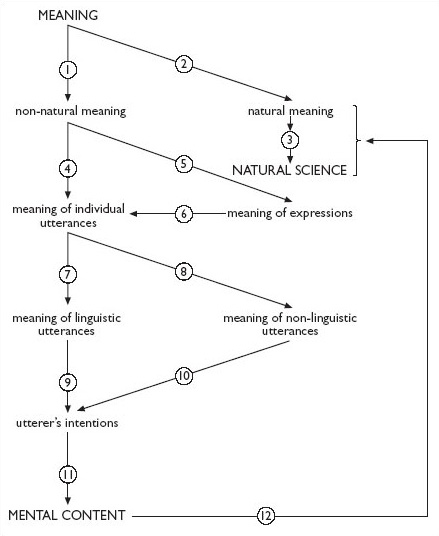2.8 The Gricean Programme
Before considering any further potential criticisms of Grice's position, let us step back and consider his wider importance to philosophy: his contribution to what is often called The Gricean Programme. Grice himself was not really a Gricean in this sense, since he was not committed to all elements of the programme that bears his name. But Grice's influence has been as great as it has in part because of the way in which his ideas have been co-opted into this broader programme.
The goal of the programme is to show that all species of representation (including the various kinds of meaning associated with language, as well as mental content) are reducible to the natural sciences. That is to say, Griceans aim to restate all uses of phrases like ‘means’, ‘represents’, ‘stands for’ and so on using only phrases drawn from the language of science. As it is sometimes put, the aim is to ‘naturalise’ the notion of representation. Grice (according to Griceans) shows us how to reduce the meaning associated with language to the content of mental states, and if the content of mental states can be reduced in turn to the natural sciences, the programme will have succeeded. One motive behind this reductionist enterprise is to give science a comprehensiveness it would lack if the notion of representation, very useful in its various guises, fell outside the main fold of science; another is to confer legitimacy on the notion itself by integrating it with the rest of science, much as biology, chemistry and physics have been increasingly integrated with one another.
The structure of the Gricean Programme is reflected in Figure 2, which I discuss below, starting at the top and following the arrows in order. The diagram looks complex, but most of it is already familiar.
We have seen already that Grice makes a plausible case for the existence of an ambiguity in the word ‘meaning’ between natural meaning and non-natural meaning (arrows 1 and 2). Natural meaning, we saw, can be thought of as a causal relation or necessary or lawlike connection (section 2.3), where these are notions that sit happily with the natural sciences (arrow 3). If we want to know whether a particular cloud configuration meansn that rain is on its way, our best bet is to ask a meteorologist.
Non-natural meaning – the kind still left mysterious after natural meaning is set aside as definable in terms of causal connections, etc. – can be distinguished into two sorts (arrows 4 and 5). This is the familiar distinction between the meaning of expressions and the meaning of individual utterances. We have just seen how Grice proposes to define the former in terms of the latter, and this is captured in arrow 6. (The outstanding matter of accounting for word meaning as opposed to sentence meaning will be returned to at the end of this section.)
We saw that Grice uses the term ‘utterance’ in a broad and slightly artificial way to mean any action with non-natural meaning. Utterances in this sense can include not only linguistic actions but many other kinds of non-linguistic action, such as the ringing of a bell on a bus. The distinction between linguistic and non-linguistic meaningful acts is, he thinks, misleading if it is taken to be a fundamental one, since all meaningful acts have something in common: the source of their meaning is the agent's intention. In the diagram, this is why the downward flow bifurcates temporarily into linguistic and non-linguistic utterances (arrows 7 and 8) but immediately comes together into a single point (arrows 9 and 10), the intention of the utterer. The content of intentions is but one kind of mental content (arrow 11).

Everything recounted so far is more or less resonant with Grice's position as it is manifested in his 1957 paper. But if the Gricean Programme stopped here it would be incomplete. For what, in scientific terms, is mental content? The final piece in the jigsaw would be a theory of mental content (including the content of intentions) in terms that are familiar from other areas of science (arrow 12). This final part of the programme – following the course of arrow 12 – is not covered in this course. But perhaps worth noting is that one approach to the content of mental states involves trying to define it in terms of what Grice has called natural meaning (hence the bracket in the diagram at the end of arrow 12).
